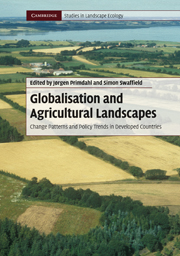Book contents
- Frontmatter
- Contents
- List of Contributors
- Preface
- 1 Globalisation and the sustainability of agricultural landscapes
- 2 Agricultural liberalisation, multifunctionality and the WTO: competing agendas for the future of farmed landscapes
- 3 Globalisation of agricultural landscapes: a land systems approach
- 4 Agricultural landscape changes through globalisation and biodiversity effects
- 5 Swiss agricultural policy reform: landscape changes in consequence of national agricultural policy and international competition pressure
- 6 Local landscape consequences of macro-scale policy reform: the New Zealand experiment
- 7 Rural landscape differentiation in the face of changing demands and policies: a typology of rural areas in Portugal
- 8 Globalisation and the local agricultural landscape: current change patterns and public policy interventions
- 9 From totalitarian to democratic landscapes: the transition in Estonia
- 10 Rural landscape change as a product of US federal policy
- 11 New approaches for urban–rural areas in Dutch spatial planning
- 12 Restoring agricultural landscapes in shrinking cities: re-inventing traditional concepts in Japanese planning
- 13 Globalisation and local agricultural landscapes: patterns of change, policy dilemmas and research questions
- Index
- References
5 - Swiss agricultural policy reform: landscape changes in consequence of national agricultural policy and international competition pressure
Published online by Cambridge University Press: 05 June 2012
- Frontmatter
- Contents
- List of Contributors
- Preface
- 1 Globalisation and the sustainability of agricultural landscapes
- 2 Agricultural liberalisation, multifunctionality and the WTO: competing agendas for the future of farmed landscapes
- 3 Globalisation of agricultural landscapes: a land systems approach
- 4 Agricultural landscape changes through globalisation and biodiversity effects
- 5 Swiss agricultural policy reform: landscape changes in consequence of national agricultural policy and international competition pressure
- 6 Local landscape consequences of macro-scale policy reform: the New Zealand experiment
- 7 Rural landscape differentiation in the face of changing demands and policies: a typology of rural areas in Portugal
- 8 Globalisation and the local agricultural landscape: current change patterns and public policy interventions
- 9 From totalitarian to democratic landscapes: the transition in Estonia
- 10 Rural landscape change as a product of US federal policy
- 11 New approaches for urban–rural areas in Dutch spatial planning
- 12 Restoring agricultural landscapes in shrinking cities: re-inventing traditional concepts in Japanese planning
- 13 Globalisation and local agricultural landscapes: patterns of change, policy dilemmas and research questions
- Index
- References
Summary
Introduction
As in many other industrialised countries, the contribution of Swiss agriculture and forestry to GDP is very low (0.8%). Despite this, every year 2.5 billion Swiss francs (CHF) are redistributed from taxpayers to farmers (SFSO, 2008b), mainly in the form of direct payments. The direct-payment system is strongly focused upon landscape conservation, and ecological and ethnological considerations. Animal welfare standards and the retirement of compensation areas are also sensitive considerations for farming in Switzerland. These payments directly influence productivity and are a highly relevant income source for the majority of farmers. As a consequence, they directly affect landscape change.
The current system originated in 1992, when Switzerland rejected economic integration with the European Union (EU) but decided to pursue a similar outcome through agricultural policy reform and bilateral agreements. The reform was initiated as a response to increasing international competition and environmental problems. It shifted emphasis away from market support and introduced decoupled direct payments. These payments are based on a cross-compliance approach to fulfil the criteria of the Green Box in the World Trade Organization (WTO) Agreement on Agriculture (Jörin et al., 2006). The first bilateral agreement came into force in 2002. It brought about tariff reductions and the removal of technical barriers to trade. By 2007, after a five-year transition period, the second bilateral agreement liberalised the cheese market between Switzerland and the EU (Jörin et al., 2006).
The combination of decoupled payments and bilateral agreements made it a challenge for Swiss farmers to maintain market share.
- Type
- Chapter
- Information
- Globalisation and Agricultural LandscapesChange Patterns and Policy trends in Developed Countries, pp. 73 - 94Publisher: Cambridge University PressPrint publication year: 2010
References
- 11
- Cited by



